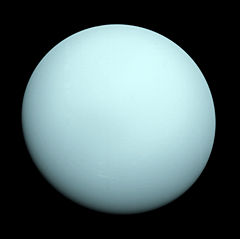Uranus

Uranus is the seventh planet from the Sun and the third-largest and fourth-most massive planet in the solar system. It is named after the ancient Greek deity of the sky (Uranus, Οὐρανός), the father of Kronos (Saturn) and grandfather of Zeus (Jupiter). Uranus was the first planet discovered in modern times. Though it is visible to the naked eye like the five classical planets, it was never recognized as a planet by ancient observers due to its dimness and slow orbit.[13] Sir William Herschel announced its discovery on March 13, 1781, expanding the known boundaries of the solar system for the first time in modern history. This was also the first discovery of a planet made using a telescope.
Uranus is similar in composition to Neptune, and both have different compositions from those of the larger gas giantsJupiter and Saturn. As such, astronomers sometimes place them in a separate category, the "ice giants". Uranus' atmosphere, while similar to Jupiter and Saturn in being composed primarily of hydrogen and helium, contains a higher proportion of "ices" such as water, ammonia and methane, along with the usual traces of hydrocarbons.[8] It is the coldest planetary atmosphere in the Solar System, with a minimum temperature of 49 K (−224 °C). It has a complex, layered cloud structure, with water thought to make up the lowest clouds, and methane thought to make up the uppermost layer of clouds.[8] In contrast the interior of Uranus is mainly composed of ices and rocks.[7]
Like the other giant planets, Uranus has a ring system, a magnetosphere, and numerous moons. The Uranian system has a unique configuration among the planets because its axis of rotation is tilted sideways, nearly into the plane of its revolution about the Sun; its north and south poles lie where most other planets have their equators.[14] Seen from Earth, Uranus' rings can sometimes appear to circle the planet like an archery target and its moons revolve around it like the hands of a clock, though in 2007 and 2008 the rings appear edge-on. In 1986, images from Voyager 2 showed Uranus as a virtually featureless planet in visible light without the cloud bands or storms associated with the other giants.[14] However, terrestrial observers have seen signs of seasonal change and increased weather activity in recent years as Uranus approached its equinox. The wind speeds on Uranus can reach 250 meters per second.[15]
Moons of Uranus

Uranus has twenty-seven named moons. Five of them are massive enough to have achieved hydrostatic equilibrium and so would be considered dwarf planets if they were in orbit about the Sun.
The first two moons to be discovered, Titania and Oberon, were spotted by William Herschel on March 13, 1787. Two more, Ariel and Umbriel, were discovered by William Lassell in 1851. In 1852, Herschel's son John Herschel gave the four then-known moons their names. In 1948 Gerard Kuiper discovered the fifth and last large moon, Miranda.
The flyby of the Voyager 2 space probe in January 1986 led to the discovery of a further 10 inner moons, and another satellite Perdita was later found after studying old Voyager photographs. Two more small inner moons were discovered by astronomers using the Hubble Space Telescope. Until 1997, Uranus was the only giant planet with no known irregular satellites. Since then, nine distant irregular moons have been identified using ground-based telescopes.
The region between the main rings and Miranda appears to be very crowded. The small moons there are constantly perturbed by each other. The system is chaotic and apparently unstable, and simulations show that the moons may perturb each other into crossing orbits which may result in collisions between the moons.[1][2]Desdemona may collide with either Cressida or Juliet within the next 100 million years.[3]
Unlike most planetary moons, which are named from antiquity, all the moons of Uranus are named after characters from the works of Shakespeare and Alexander Pope—specifically Pope's The Rape of the Lock.
